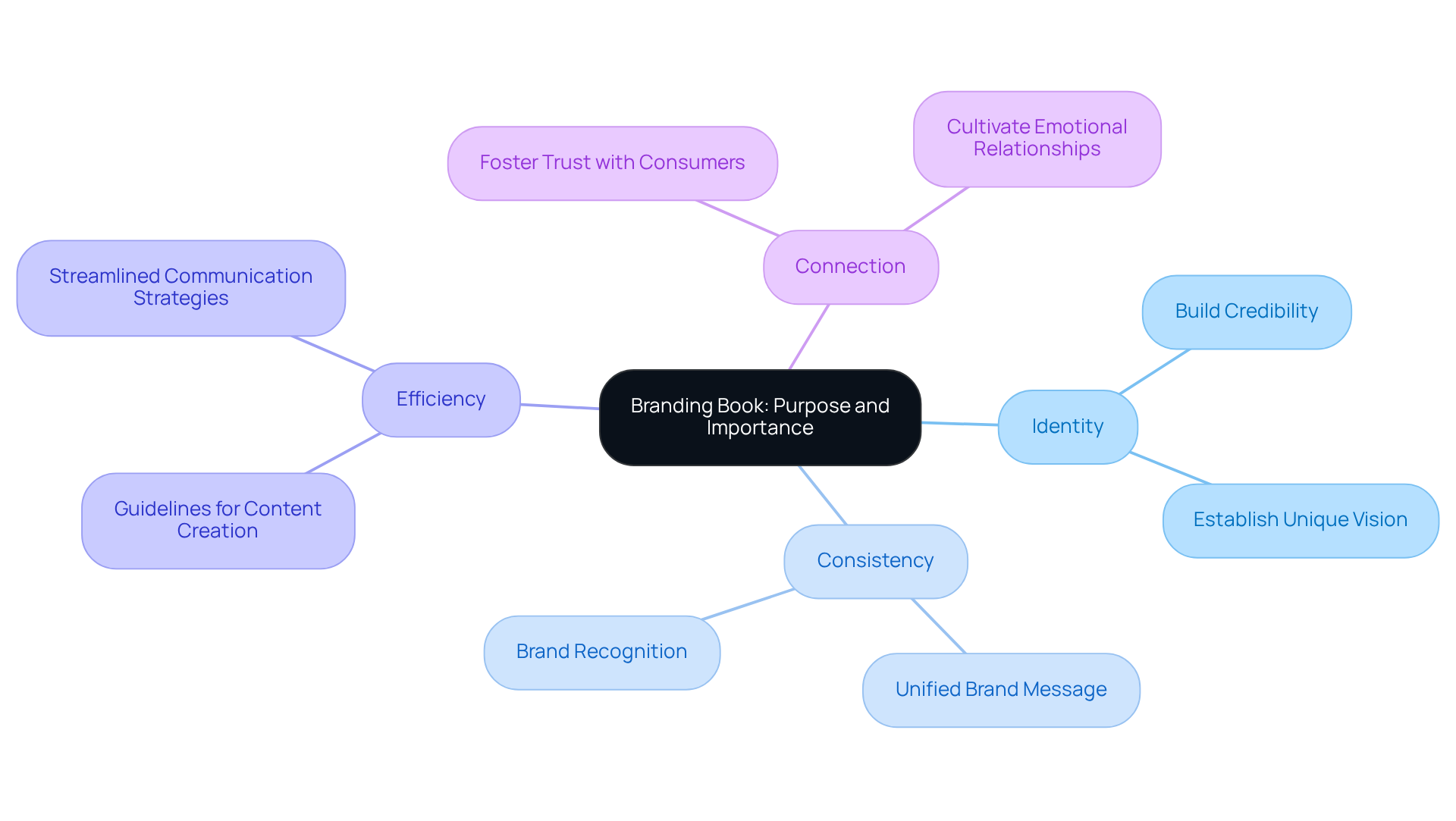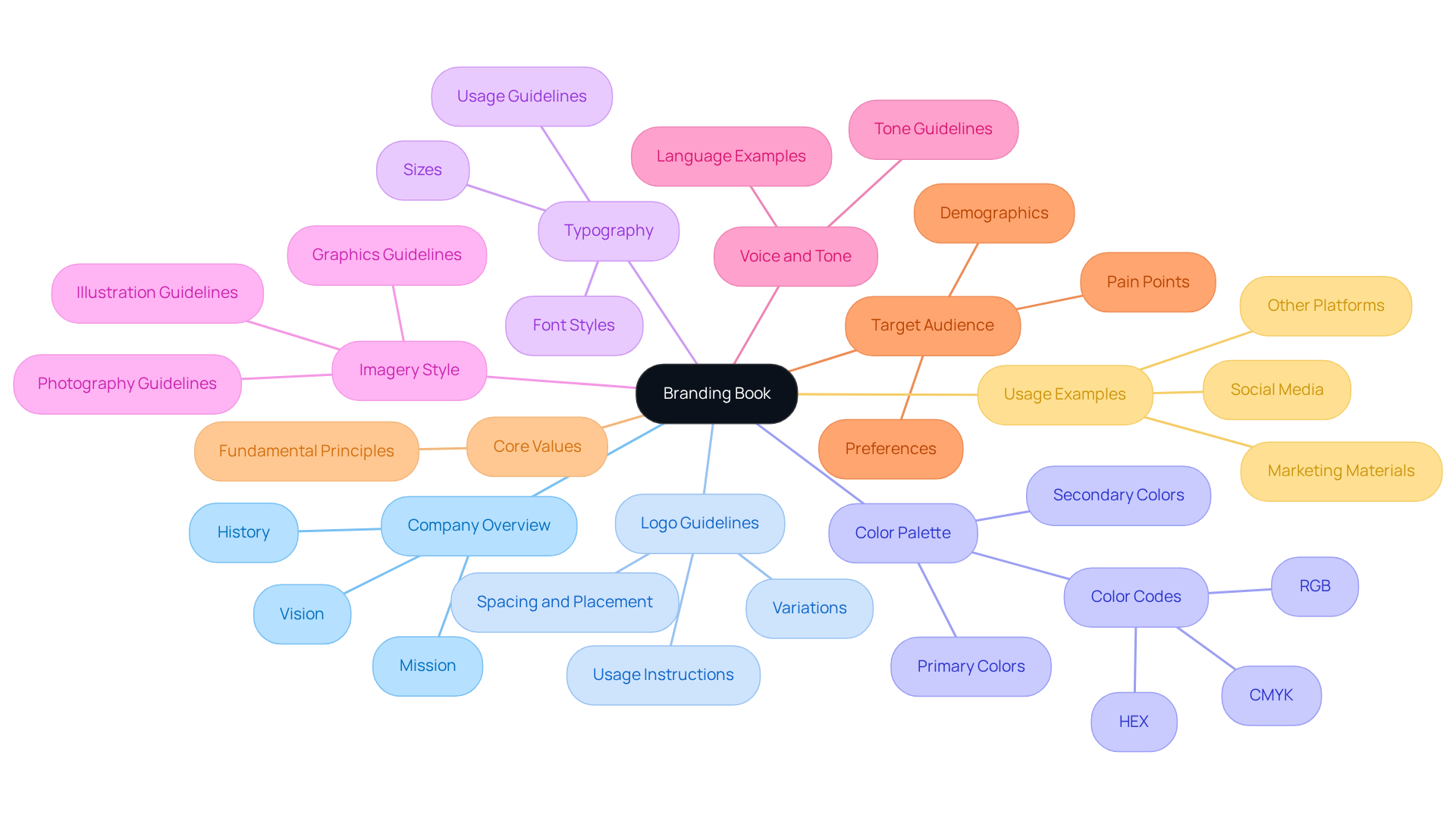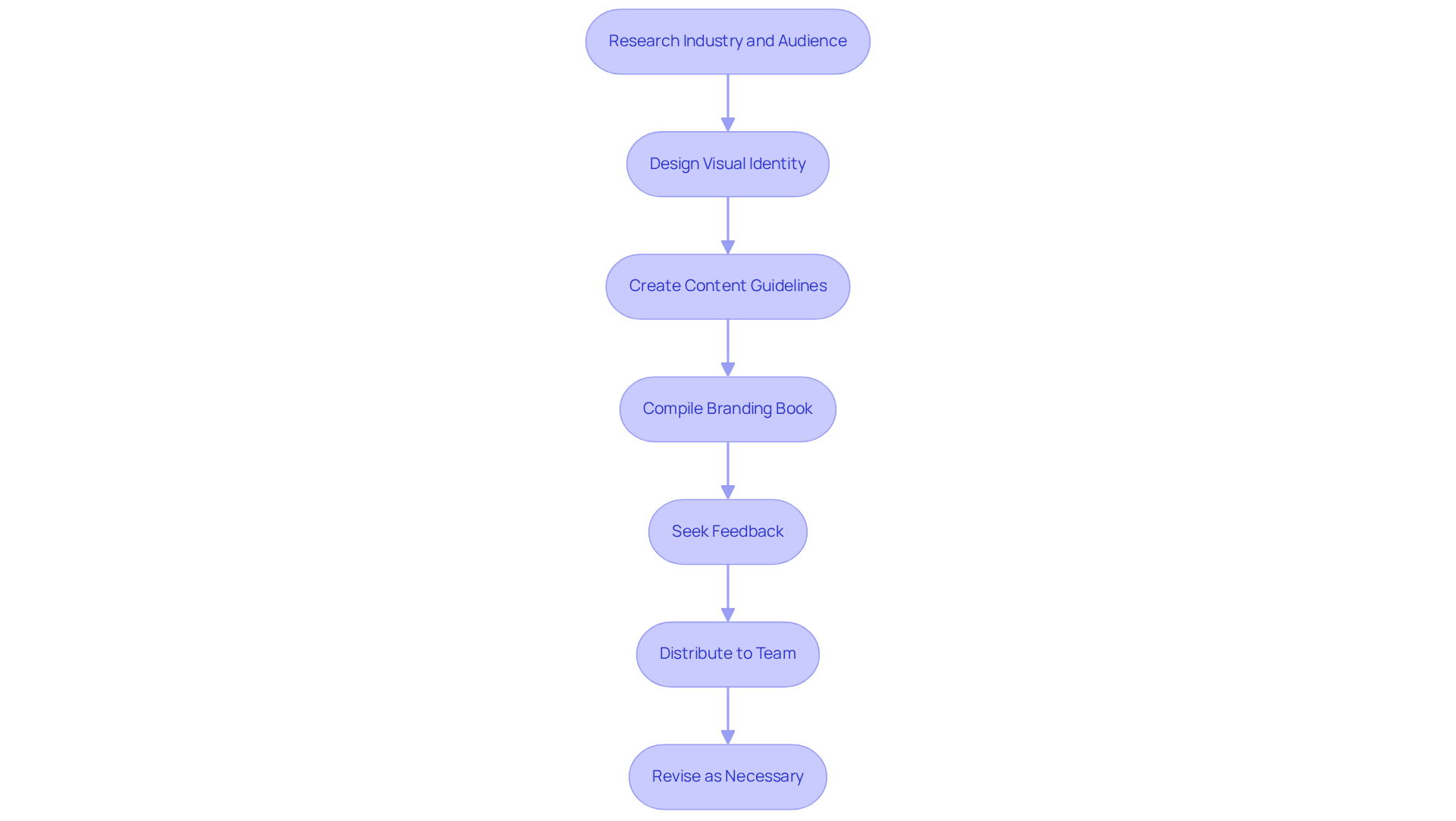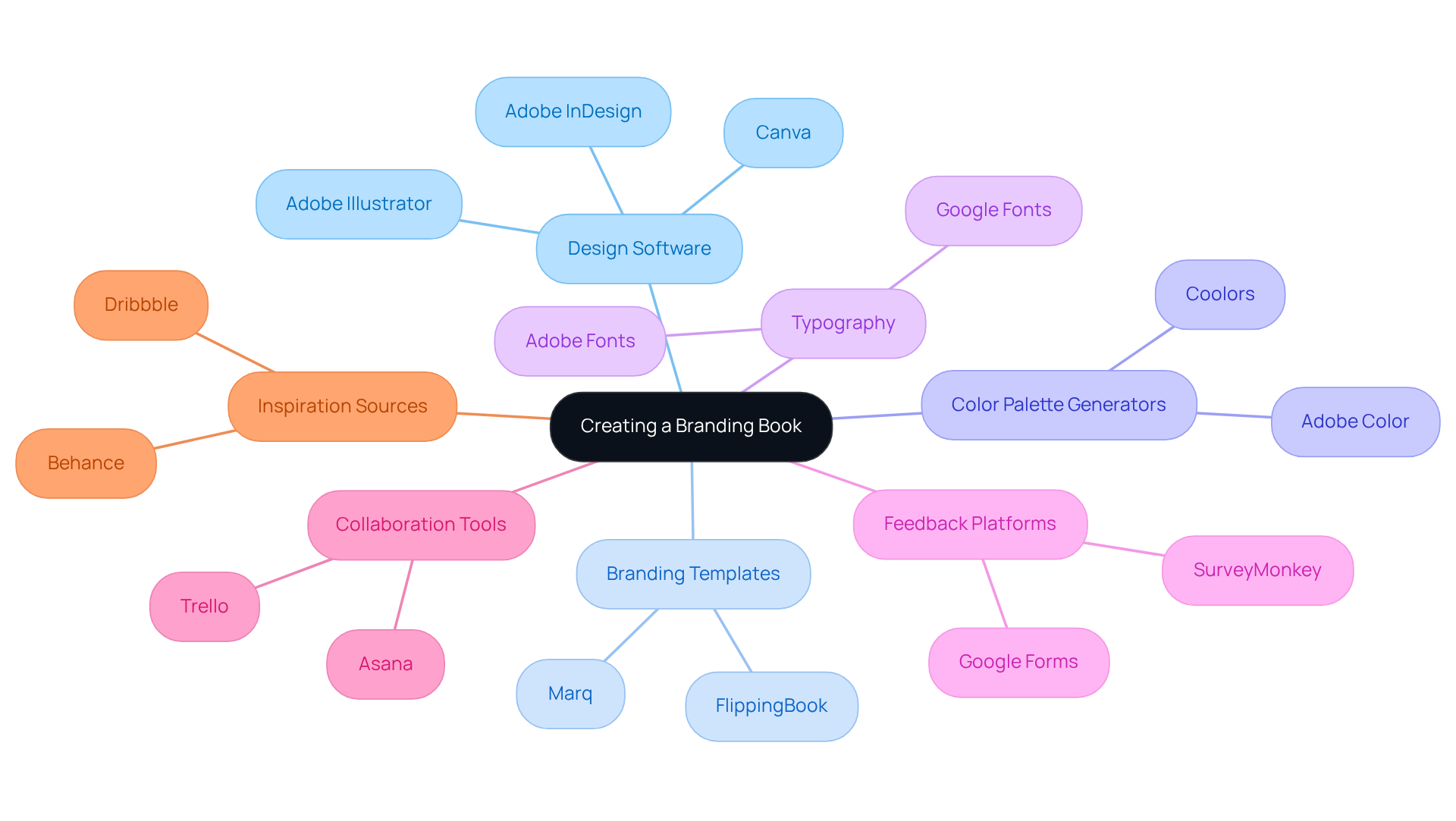Overview
Creating a branding book can feel like a daunting task for technology startups. Many founders struggle with establishing a coherent identity, which is crucial for enhancing marketing consistency and building consumer trust. This challenge can lead to confusion in the marketplace, leaving startups feeling lost and unsure of how to connect with their audience.
However, there is a solution that can help you navigate this journey. A well-defined branding book serves as a guiding light, outlining essential components such as:
- Your company overview
- Logo guidelines
- Audience profiling
By following a step-by-step process for development, you can create a branding book that not only boosts brand recognition but also drives growth in a competitive market. Remember, you are not alone in this process; many have walked this path and found success. Embrace the opportunity to define your brand's identity, and watch as it transforms your startup into a trusted name in the industry.
Introduction
Establishing a distinctive identity in the tech startup landscape can feel overwhelming, especially when competition is fierce and the market is saturated. Many founders experience the struggle of standing out in such a crowded space. A branding book can be a vital ally, providing a structured approach to consistently communicate a company's vision, mission, and values.
By exploring the essential elements and creation process of a branding book, founders can unlock the potential for enhanced credibility and recognition. Yet, it’s important to consider: what happens when the very essence of a brand gets lost in translation? How can startups ensure their unique voice resonates with their target audience amidst the noise?
These are questions that many face, and finding the answers can lead to a more authentic and impactful brand presence.
Define Your Branding Book: Purpose and Importance
For , the journey to establish a strong identity can feel overwhelming. The challenge of standing out in a crowded market often leaves founders feeling uncertain and anxious about how to present their unique vision. This is where a branding book, also known as a marketing manual or guide, becomes an invaluable ally. It serves as a beacon of consistency, encapsulating the core elements of your company's persona and ensuring that every piece of communication reflects your mission, vision, and values.
Imagine the relief of having a structured framework that not only builds credibility but also aligns everyone involved in your marketing efforts. A well-crafted style guide can eliminate confusion and foster a unified understanding of your core message, which is particularly vital for technology startups striving for success in a competitive landscape.
Moreover, a thoughtfully designed branding book improves your marketing efficiency. It provides explicit guidelines for content creation, design, and communication strategies, acting as a reliable reference for both your internal teams and external partners. This consistency nurtures trust and recognition among consumers, which is crucial for building lasting relationships. Research shows that companies with a cohesive identity can boost their revenue by 10-20%. Additionally, 85% of organizations with a branding book report enhanced brand consistency, underscoring the importance of having a thorough branding reference.
By investing in a marketing guide, technology startups can navigate their identity journey with confidence. It ensures that you resonate with your target audience and cultivate meaningful connections. Remember, you are not alone in this endeavor; many have walked this path and found success through the power of a well-defined brand. Let this guide be your companion as you embark on your journey to create a lasting impact.

Identify Key Elements: What to Include in Your Branding Book
When developing your , you may find it challenging to encapsulate your organization's essence. This is a common struggle for many, but addressing it is essential for your success. To help you navigate this process, consider including the following key elements:
- Company Overview: Start with a brief introduction to your organization. Share your history, mission, and vision to establish a solid foundation that reflects your essence.
- Logo Guidelines: Provide clear instructions on logo usage, including variations, spacing, and placement. Remember, 60% of consumers tend to avoid companies with unappealing logos. A professional visual identity can make a significant difference.
- Color Palette: Define a color scheme that embodies your identity. Specify primary and secondary colors along with their respective codes (RGB, HEX, CMYK). It's noteworthy that colors can enhance company recognition by up to 80%, making this an important aspect.
- Typography: Include specifications for fonts used in your branding. Outline styles, sizes, and usage guidelines to ensure consistency across all platforms, creating a cohesive look.
- Imagery Style: Establish guidelines for photography, illustrations, and graphics that align with your identity. This will enhance your visual storytelling and engage your audience more effectively.
- Voice and Tone: Describe your organization's voice and tone. Provide examples of language that should or should not be used. This fosters authentic connections with your audience. Research indicates that 88% of customers appreciate authenticity in marketing initiatives, so this is crucial.
- Target Audience: Create a profile of your ideal customer. Detail demographics, preferences, and pain points. Understanding these aspects is vital for tailoring your messaging effectively.
- Core Values: List the fundamental principles that guide your organization's actions and decisions. Remember, 68% of US adults select companies that reflect their personal values, so this alignment is essential.
- Usage Examples: Share real-world instances of how identity components come together in marketing materials, social media, and other platforms. This illustrates practical applications of your guidelines and can inspire others.
By integrating these components, you’ll create a comprehensive branding book that serves as an invaluable asset for anyone promoting your image. This will ultimately improve consistency and recognition, helping you to connect more deeply with your audience.

Develop Your Branding Book: Step-by-Step Creation Process
Creating your branding book can feel overwhelming, particularly in a competitive landscape. Many founders struggle to carve out a unique identity that resonates with their audience. This challenge is compounded by the fact that 53% of all trackable website traffic comes from organic search, highlighting the importance of effective branding to enhance visibility.
To address this, begin with thorough research on your industry, competitors, and target audience. Understanding what differentiates your identity and how you wish to position it in the market is essential. This foundational step will guide you in defining your organization's mission, vision, values, and unique selling propositions—elements that will form the backbone of your branding book.
Next, focus on designing your visual identity. Develop your logo, color palette, typography, and imagery style, ensuring they reflect your essence and resonate with your target audience. Remember, color can enhance recognition of a company by up to 80%, making it a critical aspect of your visual identity. Consider the investment that goes into branding; for instance, Pepsi spent around $1 million designing its logo, underscoring the importance of thoughtful design.
As you move forward, create content guidelines that outline your organization's voice and tone. Provide examples of language that align with your identity and establish guidelines for written content. Consistency is vital—81% of consumers need to trust a company to consider buying from it, and 86% believe that a company's authenticity is crucial to their purchasing decisions.
Compile all these elements into a cohesive branding book. Organize the document with clear headings, visuals, and examples to illustrate each component effectively. A well-structured branding book enhances usability and ensures clarity, facilitating your team's ability to embrace your vision.
Once you have a draft, share it with key stakeholders for feedback. This collaborative approach fosters alignment and dedication to your vision. It's worth noting that 60% of companies have found that maintaining brand consistency contributes 10% to 20% to their growth, emphasizing the financial benefits of a unified identity.
After finalizing your branding book, make sure to distribute it among your team members and partners. Ensure everyone understands how to utilize it effectively in their roles. A strong employer identity can enhance retention by as much as 28%, illustrating the value of a consistent approach.
Lastly, remember that your identity will evolve. Regularly revisit and refresh your style guide to reflect any changes in your strategy or visual representation. This adaptability is key to remaining relevant in a fast-paced market. Additionally, keep in mind that 57% of internet users will not endorse a company with a poorly optimized mobile site, which underscores the importance of maintaining a mobile-optimized style guide as part of your ongoing marketing strategy.
By following these steps, you will develop a comprehensive brand guide that acts as a valuable tool for sustaining brand consistency and promoting growth. Your journey in branding is not just about creating a logo; it's about and connects with your audience.

Utilize Tools and Resources: Enhance Your Branding Book Creation
For tech startup founders, creating a branding book can often feel overwhelming. The challenge of ensuring that your brand's identity is communicated clearly can weigh heavily on your shoulders. But don't worry; there are essential tools and resources that can help you navigate this journey with ease and confidence.
Consider starting with design software like Adobe InDesign, Illustrator, or Canva. These industry-standard tools can help you craft visually compelling layouts that truly enhance your brand's appeal. Imagine how satisfying it will be to see your vision come to life through these platforms.
Next, explore branding templates from platforms such as Marq and FlippingBook. These specialized templates simplify the structuring of your content, allowing you to focus on what matters most—your brand's message.
Color is a powerful element in branding, and utilizing color palette generators like Coolors and Adobe Color can be invaluable. These tools help you create a cohesive color palette that represents your identity, enhancing recognition by up to 80%. Picture how much more impactful your branding book will be with a thoughtfully curated color scheme.
Typography also plays a crucial role in . Access a diverse range of fonts through Google Fonts and Adobe Fonts to create a distinctive typography that resonates with your audience. The right font can evoke emotions and strengthen your brand's connection with its community.
Gathering feedback is essential, and using feedback platforms like SurveyMonkey or Google Forms can facilitate this process. Engaging stakeholders during the review stage ensures that your style guide truly resonates with your audience, fostering a sense of collaboration and shared vision.
To keep your project on track, consider collaboration tools such as Trello or Asana. These tools help manage your project efficiently, keeping team members aligned and deadlines met, so you can focus on what you love.
Lastly, find inspiration sources by exploring design elements and layouts from successful publications on websites like Behance and Dribbble. This can ignite creativity and innovation in your own project, reminding you that you're not alone in this journey.
By leveraging these tools and resources, you can enhance the effectiveness of your branding book, making sure it clearly and compellingly communicates your brand's identity. Remember, you have the support you need to bring your vision to life.

Conclusion
Creating a branding book is a vital step for technology startups striving to establish their identity in a competitive landscape. Many founders face the challenge of differentiating themselves, which can often lead to feelings of uncertainty and overwhelm. This guide highlights the importance of a branding book as a foundational tool that not only captures a company’s mission, vision, and values but also nurtures consistency and trust in communications. A well-defined branding book acts as a comforting roadmap, guiding startups through the complexities of building a recognizable and authentic presence.
Key elements such as logo guidelines, color palettes, typography, and voice and tone are essential components that contribute to a cohesive brand identity. The step-by-step process for developing this branding book—from researching the market to gathering feedback—ensures that startups can create a document that resonates with their target audience and aligns with their core values. By leveraging tools and resources, the creation process can be streamlined, making it more manageable and effective.
Ultimately, investing in a branding book transcends mere aesthetics; it is about nurturing an identity that connects with consumers and drives growth. For technology startups, this is more than just advice; it’s a heartfelt call to action: embrace the power of a well-crafted branding book to build credibility, enhance recognition, and foster lasting relationships with your audience. By doing so, your journey toward success transforms from a distant possibility into a tangible reality, one that you can confidently embrace.
Frequently Asked Questions
What is a branding book?
A branding book, also known as a marketing manual or guide, is a structured framework that encapsulates the core elements of a company's identity, ensuring consistency in communication and alignment with the company's mission, vision, and values.
Why is a branding book important for technology startups?
A branding book is important for technology startups as it helps them establish a strong identity in a crowded market, eliminates confusion, fosters a unified understanding of the core message, and improves marketing efficiency.
How does a branding book improve marketing efficiency?
A branding book provides explicit guidelines for content creation, design, and communication strategies, serving as a reliable reference for internal teams and external partners, which nurtures trust and recognition among consumers.
What are the benefits of having a cohesive brand identity?
Companies with a cohesive identity can boost their revenue by 10-20%, and 85% of organizations with a branding book report enhanced brand consistency, which is crucial for building lasting relationships with consumers.
How can a branding book help in building trust with consumers?
By ensuring consistency in communication and branding, a branding book nurtures trust and recognition among consumers, which is essential for cultivating meaningful connections.
What should technology startups keep in mind when creating a branding book?
Technology startups should ensure that their branding book resonates with their target audience and reflects their unique vision, as well as serves as a guide to navigate their identity journey with confidence.




